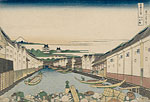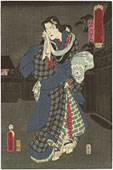|
|
|
|
|
||||||||||
HOME > the spirit of the brabd nihonbashi-bijin > Sou:Edo Nihonbashi Skillfully Expressed by Ukiyoe Artists
Artists with special skills created new traditions by absorbing the trends of their times.
Why don't you gain the beauty of Edo people by studying the history of creation that underlies the spirit of the Nihonbashi-bijin brand?
Why don't you gain the beauty of Edo people by studying the history of creation that underlies the spirit of the Nihonbashi-bijin brand?
Edo Nihonbashi Skillfully Expressed by Ukiyoe Artists


Echigoya, a kimono retail chain, had its stores widely in Suruga-cho and was one of the most prosperous shops in Edo. This piece was produced around 1789, expressing an early-spring scene with Echigoya stores on both sides of the street and Mt. Fuji and flying kites far off in the distance.
Torii Kiyonaga, who was born into Shirakoya, a bookstore in Nihonbashi Zaimoku-cho, and later became an ukiyoe artist, is characterized by his free and easy expression of people. His beautiful slender women with small faces reflect the bright atmosphere of the times. Those women have an elegance and intelligence that is attractive even from our view as modern people. The scenes of those attractive, elegant women walking in front of Echigoya, which was a trendsetting spot, seems to prove that Nihonbashi is a place that fosters beautiful women.


Nihonbashi Uogashi (Riverside Fish Market), established on the northern shore between the Nihonbashi and Edobashi bridges, was quite popular as the “kitchen” of Edo. Nihonbashi's prosperity was referred to as the “trade of a thousand ryo (an old currency unit) in the morning,” along with Shibai-cho's (that in the afternoon) and Yoshiwara's (that in the evening / at night).
Utagawa Kuniyasu, who was born in 1794 and passed away early at the age of 39, was good at bijin-ga (portraits of beautiful women) and yakusha-e (portraits of actors). This artwork expressively depicts such people as a fish vendor carrying wooden buckets hung from a shoulder pole; hard-working men wearing a workman's waistcoat, red loincloths, and headbands; and shoppers. It is said that people of the fish market were vigorous and had a strong sense of duty, with unique spirit of supporting the weak against the strong. Kuniyasu's eyes seemed to be cast on such people of the fish market.


Katsushika Hokusai, born in 1760, went out into the world when he was around 20 and was active for about 70 years. His rich sensitivity also had international influences.
The Fugaku Sanjurokkei series was created when he was around 70, and this piece of work depicts western side scenes from the Nihonbashi bridge.
Warehouses stand along both sides of the river, Edo Castle is seen in the back, and Mt. Fuji rises beyond the mist. The strong perspective contrasts the excitement on the bridge with the well-ordered cityscape and the magnificence of Mt. Fuji. Goods and materials transported to Edo Minato (a port off Sumida River) from all over Japan were delivered to warehouses along Nihonbashi River in small boats. Nihonbashi became an economically and culturally rich place as a center where produce from all over the nation collected.

 Utagawa Hiroshige was born in 1797 into a family of a doshin retainer of the shogun in charge of fire prevention in the areas along the Yayosu (current Yaesu) River, and later became an ukiyoe artist. He created the Toto Meisho series in his mid-30s, the excellent composition and fine touch of which enhanced his fame.
Utagawa Hiroshige was born in 1797 into a family of a doshin retainer of the shogun in charge of fire prevention in the areas along the Yayosu (current Yaesu) River, and later became an ukiyoe artist. He created the Toto Meisho series in his mid-30s, the excellent composition and fine touch of which enhanced his fame.The Nihonbashi bridge standing quietly covered in pure-white snow is accentuated by the surface of the blue water and the dark winter sky. For Hiroshige, who lived around Kyobashi, the bridge, the symbol of Edo, must have been a familiar scene of which he could boast. You can imagine from the work Hiroshige's intention to express the most beautiful moment of Nihonbashi by using snow, which is one of the most tasteful motifs, and visually placing Edo Castle and Mt. Fuji, which was deeply loved by Edo people.


Genya-dana, which was located in Nihonbashi Ningyo-cho 3-chome, is famous as the setting of Yowa Nasake Ukina-no Yokogushi, a kabuki drama first performed in 1853. The setting of the scene where Otomi and Yosaburo who had thought the other was dead met again by accident was replaced by Genji-dana in Kamakura in the original book, but it's actually Genya-dana. There was the feudal house of Okamoto Genya, an official doctor for the shogunate, in the area around here, which was a calm residential place a little distant from the city's noises.
Utagawa Toyokuni the 3rd (Utagawa Kunisada) created a great number of yakusha-e (portraits of actors) and other works, estimated at more than 10,000, until he passed away at the age of 79. His expressiveness is shown in this excellent work as well, where Otomi's stylishness after having taken a bath is emphasized by the quiet row of houses.
Source: Daiichikosho Co., Ltd. and J Story Co., Ltd.
|



